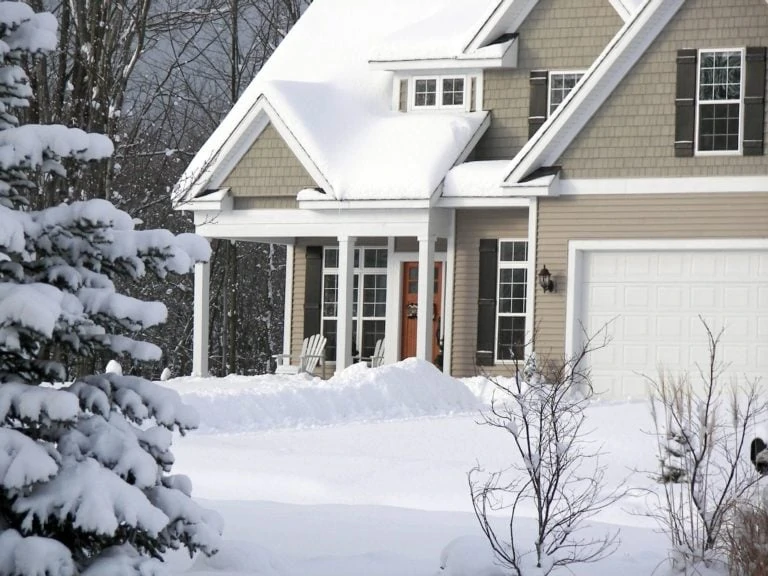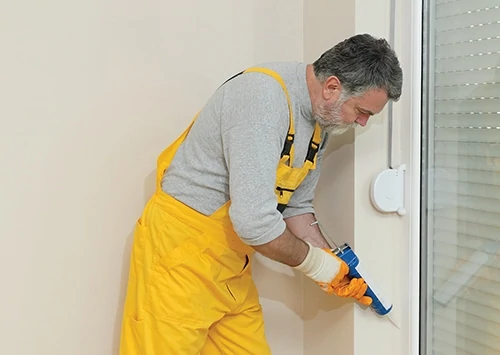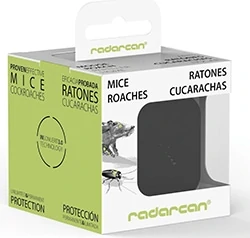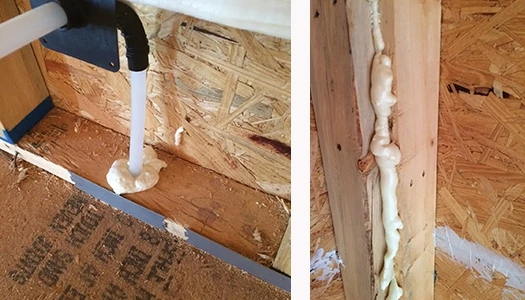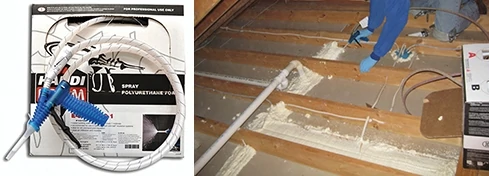By Tom Matthews
Search for Leaks
Whether through walls, floors, the ceiling or ductwork, air leaks represent money out the window. In cold weather, warm air rises into the attic of the home. As it enters the attic, it leaves the living space, which you’re paying to heat. It also pulls in cold outdoor air from other cracks and crevices in the home, around doors and windows, and through the basement. In essence, these leaks create a vicious cycle that can drain away energy and money. Inspect your home care-fully for any leaks, which can be difficult to find when hidden beneath insulation. Some common problem areas include the attic hatch, plumbing vents, wiring holes, recessed lights and the soffit boxes that contain them.
A simple way to check for air leaks is to use a burning candle. On a cool, windy day, close all doors and windows and turn off the furnace. Turn on all the vent fans in the house to encourage the leaks. Move the lit candle around the edges of doors and windows. Look for the smoke to flutter or the flame to flicker, which indicates a leak.
Test the rooms’ temperature.
If temperatures differ more than 1 or 2 degrees in various areas of a room, it may be poorly sealed. Apply weather-stripping and/or caulking as necessary, then retake the temperatures. (If the differences persist, you may have an HVAC airflow problem.)
Certain spots in the home are particularly vulnerable to air leaks. Check round the furnace flue or the duct chaseway (the box that hides the ducts) for leaks. Next, investigate indoor areas including heating and dryer vent penetrations, gaping baseboards and cracks along sill plates and floor-to-wall junctions. On the outside, look for leaks at the bottom of siding edges where they meet the foundation, along garage ceiling and wall joints, and all electric, gas and A/C penetrations. Also examine the basement rim joists and all windows and doors.
Consider investing in an infra-red thermometer for a DIY home energy audit. For as little as a hundred bucks, handheld laser-sighted tools can help detect energy loss around doors and windows, insulation, ductwork and other areas throughout the home.
Fill the Gaps
Once you’ve pinpointed air leaks, close them off. Use caulking between nonmoving parts of the home with caulking/sealant. You can use a wide variety of products, such as caulk with foam backer rods (for large gaps), as well as silicone-, water-, or rubber-based sealants.
The easiest way to parse the many options in caulks/sealants is to pay close attention to the indications on the packaging, making sure they match the job at hand. Whether the product is flexible, waterproof, paintable, or contains a mildewcide additive, all features should be listed prominently on the label, and you generally get what you pay for.
Another popular sealant is spray-in expandable foam, which comes in an aerosol can. It’s important to select the right insulating foam for the job; too much expansion in the wrong place can put unwanted stress on the construction. Use the “no warp” formula of expandable foam around windows and doors.
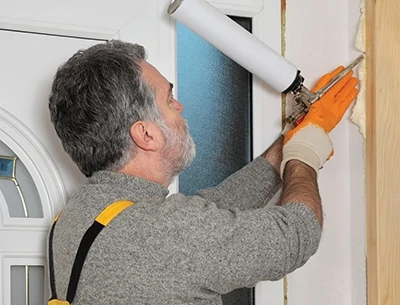
Seal leaks between moving parts of the home with various types of weather-stripping:
Compression Strips include open- and closed-cell foam or rubber tapes, as well as tubular strips. The open-cell tape will give you a quick fix until you can properly measure and fit a permament solution. Closed-cell tapes allow you to correctly size the gap you are working with and are more durable for doors and windows that are used often. Use where there is a pressure stress: along the bottom of vertical sliding windows, around attic hatches or on hinged windows and doors.
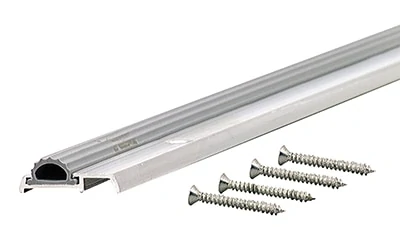
Tension Strips made of spring vinyl or spring metal are used in similar applications as compression strips. The spring mechanism adapts to long unequal distances from the weather-strip to the door or window.
Combination Types include spring-loaded, self-adjusting strips or magnetic strip systems, which are both effective for doors and hinged windows.
Door Sweeps, Bottoms and Thresholds seal the gap between the door and the floor. Sweeps and bottoms are often made of vinyl or rubber and attach to the bottom of a door. Thresholds attach to the floor, require clearance beneath the door, and include a vinyl or rubber strip for an excellent draft seal.
Elsewhere around the House
Your local hardware store or home center is likely stocked with a number of specialty sealer products for areas of the home that often go overlooked. When giving your house its annual physical exam, don’t forget these crucial areas.
Windows. Ideally, your home should have double pane and low-emissivity coated window glass. You can also insulate your windows using heat-shrink plastic insulation. One option for wooden-frame windows is to cover the outside with heavy plastic to reduce cold air infiltration. Staple the sheeting over the outside, leaving a 4-inch overhang at the perimeter. Secure the edges with wooden furring strips, fasten to the outside window frame, then trim off the excess plastic.
HVAC. Have an HVAC technician do a full inspection of your furnace for proper performance. If the furnace is made of old-fashioned sheet metal ductwork, consider replacing it with insulated ducts, including the plenum. If you use propane or heating oil, ensure that the tank has been filled. Use an insulated air-conditioner cover over window units to do the same.
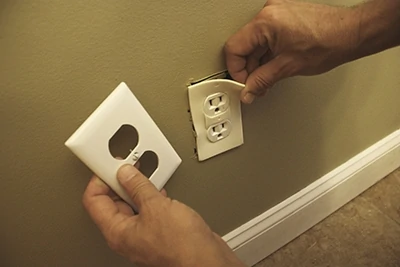
Outlets. Consider using fitted foam gaskets around electrical outlets (behind the switch-plates) to prevent air transfer. This is a commonly overlooked gap because it’s hidden from view.
Plumbing. Insulate outdoor hose bibs and exposed plumbing, including those in unheated crawlspaces. If you go on a winter vacation, leave your heat set to at least 50 degrees Fahrenheit so pipes don’t freeze.
Gutter and Roof. Replace worn or damaged roof shingles or flashing, and clean out the gutters to prevent ice dams. An ice dam is |a ridge of ice that forms at the edge of a roof and stops melting snow from draining. This causes backed-up water to leak into the home. Clean your gutters to ensure proper drainage, and install gutter covers to prevent debris accumulation. Proper attic ventilation also removes heat and keeps the roof deck evenly cool to prevent uneven melting of the ice.
Chimneys. Have a pro chimney sweep inspect, clean, and repair any fireplaces, flues, or wood stoves. Add chimney or flue caps to keep out birds and pests. Tuck-point or repair any loose masonry, and make sure the dampers work on fireplaces and stoves.
Attic. Inspect the attic for evidence that the weather seal of the house has been broken. Check for any wet or damp insulation and moldy, rotted attic rafters or ceiling joists, any of which could indicate a leaky roof. Address any problems before they can worsen.
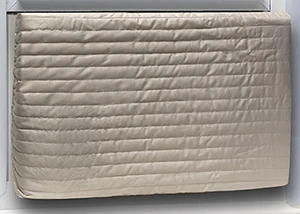
Basement/Foundation. Install covers over the crawlspace ventilation openings. Cover basement windows with plastic shields. Rake leaves and debris away from the foundation. Seal foundation cracks and other openings to keep out mice and other pests.
Keep Pests Away
Some pests disappear during winter, but not all. In fact, cold, wet or snowy weather is likely to drive pests to seek the warmth and shelter of the indoors. Sealing your home will go a long way toward keeping them outside. Eliminating conditions in your home that appeal to pests, such as open food containers, will also help reduce the attraction. Sink and floor drains often accumulate gunk that can attract pests and provide an ideal breeding site, especially for small flies, so clean and disinfect these areas. Store recyclables outside and away from your home and make sure all containers are thoroughly rinsed and have tight-fitting lids.

To reduce flying bugs around doors and windows, replace standard mercury vapor lights with high-pressure sodium vapor or halogen lights. Bulbs that have pink, yellow or orange tints are less attractive to flying insects.
The EHT staff periodically sprays our homes with the same household insect repellents commonly available at homes stores. In many cases, the insecticide is the same chemical used by professionals, although professionals occasionally rotate use of different products on the same property to reduce the likelihood that pests will develop a tolerance to a particular type.
Before applying any spray pesticide treatment, send kids and pets outside to play or to another room in the house. Apply the product along baseboard areas, around doors and windows, and to any problem areas. Allow it to completely dry before returning to the treated area. Some products, such as foggers, require you to leave your home altogether.
If you aren’t comfortable with the chemical pollutants of pesticide, then consider one of the newer electronic pest repellers. Companies such as Radarcan offer a variety of repellers that emit ultrasound waves that are unbearable to pests such as mice and cockroaches, driving them away from the area for hundreds of square feet. It eliminates the need to set and empty mousetraps and provides an alternative solution for allergy sufferers or people with respiratory problems.
Side Note 1
Seal Leaky Doorways
Even the most energy-efficient HVAC systems can still cost plenty if warm or cool air is wasted through leaky doors. As a house settles over time, door frames often shift, creating a gap around the perimeter. A general rule of thumb: If you can see light between the closed door and the jamb, you have a problem. If this happens to a door leading outdoors or to an unconditioned living space, it equates to leaving a window cracked. The solution here is to install a simple weather-stripping kit.
One of the best types for doors has a rigid aluminum bar along with a soft rubber gasket, called a bulb. The bulb compresses against the closed door to prevent the passage of air and moisture. The kits are usually sold with three pieces—one for the top and two for the door sides (screws included). The pieces often come in standard door heights, but any of the three components can be trimmed to size.
The only tools you’ll need are a drill/driver, measuring tape and a hack saw.
Side Note 2
Seal all Gaps While You Can
A friend of the EHT staff, Keith Lively, contracted construction of a new house and decided to do much of the work himself. One night after the house was framed and the sheathing installed, he noticed something as the sun set: light. Lots of light shone throughout the house framing and sheathing panels. Anywhere light can pass, so can unconditioned air, so Lively took the opportunity to seal his new house before the insulation and drywall were ever installed. Every pipe, seam and joint got a dose of caulk/sealant or expandable foam to keep air transfer low and energy bills to a minimum. If you ever build a home, or add a wing to your existing one, you should do the same and seal all the gaps while you can reach them.
Side Note 3
Air Sealing the “Critical Seal”
Air-sealing your attic floor (the “critical seal”) is an important step in winterizing your home—more important than replacing your windows or adding more fiberglass. The reason is that heat rises, finds all the cracks and holes in your ceiling, and escapes into your attic. This accounts for roughly 40 percent of heat lost by a building in the winter months. Air escapes through recessed lights, electrical wire penetrations, holes around pipes, air ducts/registers/boots, attic hatches, top plates and more. Fiberglass insulation alone will not stop this air movement, as evidenced by the dirt that accumulates in insulation around holes in your ceiling (the fiberglass acts like a filter). Stand-alone, expanding spray foam kits such as the FOAM605 kit or FOAM105 kit from Energy Efficient Solutions provide a true air seal, give twice the R-value per inch than traditional insulation, and expand to fill all of the cracks and crevices. Learn more at www.energyefficientsolutions.com.


